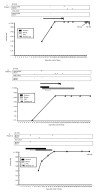Microbiologic characteristics, serologic responses, and clinical manifestations in severe acute respiratory syndrome, Taiwan
- PMID: 14519257
- PMCID: PMC3016775
- DOI: 10.3201/eid0909.030367
Microbiologic characteristics, serologic responses, and clinical manifestations in severe acute respiratory syndrome, Taiwan
Abstract
The genome of one Taiwanese severe acute respiratory syndrome-associated coronavirus (SARS-CoV) strain (TW1) was 29,729 nt in length. Viral RNA may persist for some time in patients who seroconvert, and some patients may lack an antibody response (immunoglobulin G) to SARS-CoV <21 days after illness onset. An upsurge of antibody response was associated with the aggravation of respiratory failure.
Figures


References
-
- Hon KLE, Leung CW, Cheng WTF, Chan PKS, Chu WCW, Kwan YW, et al. Clinical presentations and outcome of severe respiratory distress syndrome in children. Lancet April 29, 2003. Available from: URL: http//image.thelancet.com/extras/031et4127web - PMC - PubMed
MeSH terms
Substances
LinkOut - more resources
Full Text Sources
Research Materials
Miscellaneous
